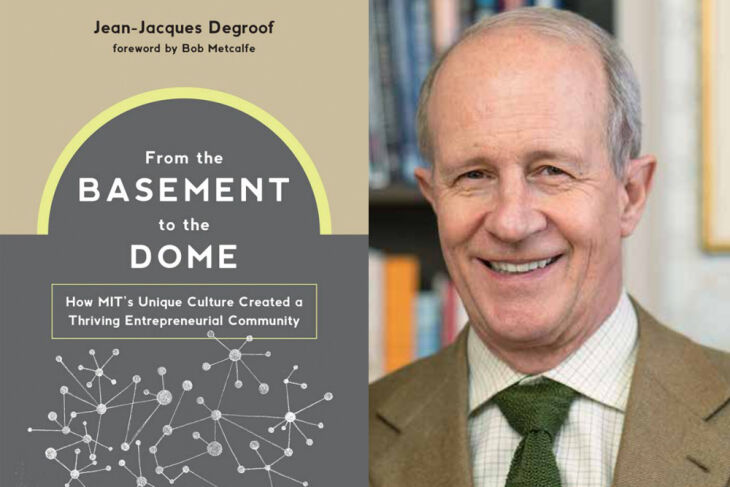There are tens of thousands of companies founded by MIT alumni operating around the world today. Those companies employ millions of people and generated nearly $2 trillion in annual revenue as of 2015. To train the next generation of founders, MIT offers more than 200 resources dedicated to fostering entrepreneurship and innovation, including more than 80 courses and dozens of extracurricular activities.
So how did MIT get here, and what makes the Institute’s entrepreneurial community so prolific? In his new book, “From the Basement to the Dome: How MIT’s Unique Culture Created a Thriving Entrepreneurial Community,” Jean-Jacques Degroof SM ’93, PhD ’02, a venture investor, dives into the history of MIT entrepreneurship, before carefully detailing the state of affairs today and offering some lessons learned.
It turns out, things didn’t always used to be this way, and MIT’s entrepreneurial support structures look much different from what they looked like even 10 years ago. MIT News spoke with Degroof about some of the findings in his new book.
Q: How did MIT become so entrepreneurial?
A: The short answer is, primarily from the bottom up. Until the early 2010s, interest in entrepreneurship materialized through a myriad of local, informal initiatives, primarily in the extracurricular arena; MIT’s central administration did not have a deliberate policy toward entrepreneurship on campus. In the late ’60s and ’70s, some young alumni entrepreneurs in Boston convinced the alumni office to organize the first series of entrepreneurship-focused seminars. It was a huge and unexpected success. That eventually led to the MIT Enterprise Forum, run by MIT alumni. Then in the late ’80s, students from the School of Engineering and the MIT Sloan School of Management launched the Entrepreneurship Club and the Sloan New Venture Association (SNVA). They started the $10K Business Plan Competition (which eventually became the successful $100K Entrepreneurship Competition).
In 1990, Professor Ed Roberts of Sloan, a pioneer in entrepreneurship on campus, founded the Entrepreneurship Center, now the Martin Trust Center for MIT Entrepreneurship, in response to student requests for guidance in starting new businesses.
From there, student clubs, entrepreneurial competitions, and other entities providing support to entrepreneurs multiplied over the years, especially during and since the internet era. This was all thanks to the efforts of alumni, students, and individual faculty and staff members, who lobbied their administrations.
Following the growing interest of students, Sloan and the Media Lab in particular developed course offerings. Another turning point was after the 2008 financial crisis. As traditional large employers hired fewer graduates, entrepreneurship appeared for the first time as a valid career path for students.
Students were also attracted to entrepreneurial firms because of promising technological developments in the mid to late 2000s. The iPhone launched in 2007, there was the internet of things, cloud computing, the genome revolution, the convergence of biotech and information technology, engineering at the nanoscale, clean energy, and the explosion of real-time information in general. The center of gravity of the economy was increasingly moving from the traditional employers to new, disrupting firms.
Around that time, roughly 2010, MIT’s central administration more formally embraced entrepreneurship with the Innovation Initiative and programs like the minor in innovation and entrepreneurship.
Q: You argue that MIT’s culture has been a fertile ground for entrepreneurship. What specific parts of MIT’s culture do you think align with entrepreneurship?
A: There is an excellent fit between several elements of MIT’s culture and entrepreneurship:
- Openness to bottom-up initiatives and decision making. This is particularly strong at the level of MIT centers and laboratories. They are set up by individual faculty members — who need to find funding to sustain their lab. As such, they are academic entrepreneurs in a way.
- Excellence. MIT ranks among the best universities in the world, so excellence is a core value. Launching and growing a company can feel like hell at times and requires excellence and dedication. The MIT experience absolutely prepares its people for uphill battles and humbling experiences.
- Learning by doing and problem solving. Since its founding, MIT has put a lot of emphasis on experiential learning through lab work and internships, for instance. Similarly, entrepreneurship requires you to go out into the real world and iterate on your ideas.
- Experimenting and tolerance to failure. Entrepreneurship fits perfectly into such an approach because it is also a process of experimentation and trial and error.
- Multidisciplinarity. Solving real-world problems often requires solutions combining multiple approaches. Innovating through entrepreneurship generally requires people to think outside of the box and imagine solutions that often involve several disciplines. One of the few reliable rules drawn from research in entrepreneurship is that diverse teams of startup founders perform better.
- Impact. MIT’s motto, mens et manus (“mind and hand” in Latin), and its logo — which features the scholar and the craftsman in parallel positions — reflect the ideal of cooperation between knowledge and practice, but also a concern about impact. Entrepreneurship fits this philosophy perfectly as a process to make impact on the world.
- Embracing the outsider. For a long time, MIT was seen as an outsider by its peers in academia and looked upon as a mere vocational school. This identity of being an outsider is still alive in the MIT community, but it is accompanied by a sense of pride in being disruptors, upstarts, and even a bit geeky. Having an identity outside the establishment fits entrepreneurs well, who by definition try to challenge incumbents.
All this illustrates that MIT’s environment is difficult to replicate.
Q: What do you hope this book teaches readers about supporting entrepreneurship?
A: It is important to build an entrepreneurial ecosystem that builds on one’s institution’s culture, or at least does not go against it. Simply copying and pasting another institution’s model is not a promising approach. Entrepreneurship training should also go beyond simply pitching a business plan. One should not underestimate the resources required for putting in place an entrepreneurship curriculum. Institutions that do not have the required scale should consider pooling resources with peer institutions.
Developing an entrepreneurship curriculum and internal ecosystem should also involve a variety of stakeholders, including large corporations, providers of risk capital, and government. The involvement of alumni is particularly key because they can contribute as lecturers, mentors, and donors. They can also be a channel to other stakeholders, all of which can facilitate the promotion of entrepreneurship locally.















